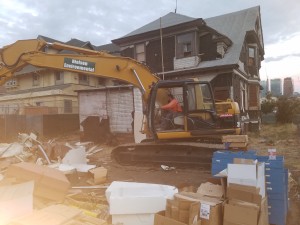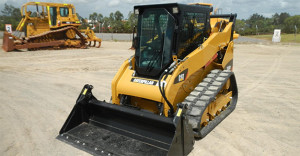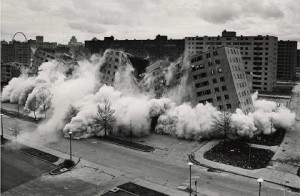Demolition Services Malibu, CA
 Demolition brings to mind spectacular images of buildings falling in a controlled, pancake fashion (also known as a building implosion), with mushroom clouds of dust settling like snow over the immediate surrounding area. We've all seen the videos--it's an awesome sight, but one inherently full of danger. Someone requiring a demolition service is looking for the demo contractors who will perform the tear down in a safe, timely manner, minimizing risk and maximizing cost effectiveness. But demolition services Malibu, CA offers isn't as simple as it looks; what you see in those videos of buildings collapsing is the end result of a painstaking process that involves the highest levels of expertise in planning. There are many different kinds of demolition, depending on such factors as the size of the building and the amount to be removed, which is why it's important to know exactly what is required for each structure. What makes Nielsen Environmental different is that we modeled ourselves using the renowned Turner Construction as our gold standard; by using Nielsen Environmental, you will have the benefits of working with a small contractor that is organized, professional and speaks personally to the client’s needs. We have demonstrated our ability to perform successfully in both the private and public sector.
Demolition brings to mind spectacular images of buildings falling in a controlled, pancake fashion (also known as a building implosion), with mushroom clouds of dust settling like snow over the immediate surrounding area. We've all seen the videos--it's an awesome sight, but one inherently full of danger. Someone requiring a demolition service is looking for the demo contractors who will perform the tear down in a safe, timely manner, minimizing risk and maximizing cost effectiveness. But demolition services Malibu, CA offers isn't as simple as it looks; what you see in those videos of buildings collapsing is the end result of a painstaking process that involves the highest levels of expertise in planning. There are many different kinds of demolition, depending on such factors as the size of the building and the amount to be removed, which is why it's important to know exactly what is required for each structure. What makes Nielsen Environmental different is that we modeled ourselves using the renowned Turner Construction as our gold standard; by using Nielsen Environmental, you will have the benefits of working with a small contractor that is organized, professional and speaks personally to the client’s needs. We have demonstrated our ability to perform successfully in both the private and public sector.
But what about navigating through the complex world of demolition? Here's a list of important terms and definitions to keep in mind:
Demolition by definition is the wrecking or taking out of any load-supporting structural member of a facility along with any related handling operations, or the intentional burning of any facility. This process can also include moving a structure off its foundation. For small buildings like one-to-three story homes, demolition is a relatively easy process; the building is taken apart manually or mechanically using large excavators, elevated work platforms, cranes and bulldozers. Larger buildings in the past required a wrecking ball, which does work good on masonry but is less easily controlled and often less efficient than other methods. The newer methods of rotational hydraulic shears and silenced rock-breakers which are attached to excavators that cut or break through wood, steel and concrete, are much more efficient. Shears are also helpful when flame cutting is dangerous.

Selective Demolition
Selective demolition is defined as a careful demolition procedure whereby parts of a structure are removed while the primary structure is protected and remains intact. Selective demolition procedures use a combination of hand labor and small, specialized equipment. Examples of selective demolition are listed below:
- Removal of interior features such as walls, ceilings and utilities-this is a very common procedure during remodeling work.
- Cutting openings in walls and floors for new utility services, stairwells, elevators, windows, doors etc.
- Removing entire floors for major remodeling projects.
- Removing portions of structures that have become deteriorated or otherwise unusable.
- Removing portions of structures that have been damaged by fire, earthquakes, and similar events.
- Cutting and removing slots between parts of the building to be demolished, while the other part remains intact.

Renovation: altering a facility or one or more facility components in any way, including the stripping or removal of Regulated Asbestos Containing Material (RACM) from a facility component.
Modern Demolition Practices
Typical equipment used for selective demolition work include the following:
- Skid-steer loader
- Small excavator
- Robotic excavators equipped with breakers and shears
- A wide variety of attachments for skid steer loaders and mini excavators
- Aerial lifts and scissors lifts
- Scaffolding

Hand Tools used in selective demolition include the following:
- Abrasive and reciprocating saws
- Pneumatic tools such as pavement breakers and chipping guns
- Concrete saws
- Chain saws
Salvage
In the past, the salvage of building materials was the primary purpose for most early demolition efforts. The term "salvage" takes several forms, and the more important types and methods of salvaging are shown below. The values of salvage sales to the demolition contractor can represent a significant portion of his or her income stream, and allow for increased competitiveness if he or she is reasonably accurate in the assessment of the salvage values for a particular job.

- Equipment Salvage-industrial buildings in particular as well as some modern commercial buildings, may contain useable equipment such as boilers, air conditioning systems, heat exchangers, tanks, electrical switchgear, motors, pumps, and a wide variety of industrial process equipment. Usually, these types of salvage are carefully removed by the demolition contractor prior to beginning tear down operations.
- Useable Materials Salvage-this category of salvage primarily includes timbers, dimensional lumber, piling, structural steel members, piping, and some types of brick.
- Scrap Metals Salvage-steel scrap produces by far the largest share of the salvage income for the demolition contractors. Other important metals such as cast iron, copper, brass, aluminum, and lead are typically removed from the waste stream and sold to scrap recyclers.
- Architectural Features-these items are sometimes referred to as "historic fabric" and include any part of a building that has value. Architectural features of certain buildings that no longer have adequate commercial value are sometimes salvaged for use in the façade or interior areas of new construction. Antique equipment may also be considered as historic and is sometimes salvaged for museum displays. At times, the issuing of a demolition permit is predicated on the demolition contractor agreeing to carefully salvage specific items considered to be of historic value.
Hazardous Material Management
The proper management of hazardous materials is important to the successful operation of a demolition project. Although the demolition contractor may not have the contractual requirement to remove and dispose of hazardous materials, it is important that they are familiar with the hazardous waste management plan in force for each project. Many of the larger demolition companies are qualified to perform hazardous materials work with their own forces, whereas other demolition firms will typically use companies that specialize in handling hazardous materials. The hazardous waste contractor may work directly for the project owner, as a sub contractor to the demolition contractor, or as a subcontractor to a general contractor. It is important for a demolition contractor to determine his contractual and legal responsibilities for identifying and handling hazardous materials before submitting a proposal for demolition to either an owner or general contractor. No matter who has the contractual responsibility for hazardous waste removal, every contractor working on a demolition project has the responsibility to protect their employees and the public from hazards that exist on the project.
Building Implosion
Large buildings, industrial, smokestacks and some smaller structures can be demolished by a building implosion using explosives. The implosion of a building is completed very fast, and the collapse takes only a few seconds. Experts in this highly regulated field ensure that the building will essentially fall into its own footprint. This is very important, so as not to damage the neighboring structures. Obviously any error can be disastrous, and some tear downs have failed and damaged neighboring structures. In addition, when a building fails to fall down completely the structure may be unstable and tilted at a severely dangerous angle--not to mention filled with explosives that have not yet detonated, making it very difficult to bring in workers to access the project safely.
Another danger is the overpressure that happens during an implosion. If it's a clear day for example, the shock wave of energy and sound travels upward and disperses, but if low clouds over the implosion are below 1,200 feet the shock wave can travel outwards, breaking windows and causing other damage to buildings. It's sort of like putting your hand in front of a water hose, and watching it fan out to the sides--a simple effect of physics that's fun for a child with a hose, but disastrous in a building implosion!

Preparation
It takes several weeks or months to plan for implosion depending on the size of the project. All valuable items are stripped out of the building including the copper wire. Other material like glass must be removed so as not to send deadly projectiles and insulation that can scatter a large area. Hazardous waste like class 1 asbestos is contained in TSI wall surfacing material, and fireproofing. In addition e-waste such as light bulbs, PCBs, metal studs and drywall are removed in the process of getting the building stripped down to its core. When this work is completed selected columns are used to set explosives on different floors of the building, then holes are drilled and high explosives such as nitroglycerin (TNT) are stuffed inside the holes. The smaller columns are usually wrapped in detonation cord. The overall goal is to use as little explosive as possible, so the building will fall in a progressive collapse; this way only a few floors are actually rigged with explosives, making it much safer and more cost effective. The explosive areas are covered with thick geotextile fabric and fencing to absorb debris, keeping it from flying and causing injury. The clean up of the site is also far more time consuming than the demolition itself, as debris must be loaded into trucks and safely hauled away.
Deconstruction
Deconstruction is a newer approach to demolition with a goal to minimize material that goes into landfills. This "green" approach is accomplished by separating by material type for reuse or recycling. This type of approach and planning can result in landfill diversion rates that exceed 90% of the entire building; this process also reduces CO2 emissions compared to demolition. On very large sites, equipment is used for the segregation of waste types that can be used over in the construction of the new building. Onsite crushers take the concrete and smash it down to be reused as a Type 1 crushed aggregate, to be used either as a piling mat or for a base that is compacted into the earth below the new building, or to be used as an aggregate in concrete mix. Timber waste is shredded using equipment and then composted, or used to make timber boards like MDF or OSB. Safety is crucial on a project of this magnitude, and a safety officer is assigned to enforce all safety regulations.
Analyzing the Demolition Project
These are the essential questions that should be asked before proceeding with any demolition project. Demo contractors take these queries into account as they assess the project proposal:
- How complex is the project?
- Is the project suitable for the company's operations?
- What submittals are required?
- How is safety and risk assessment to be controlled?
- How is the schedule to be developed, and who controls it?
- What equipment will be ideal for the project?
- How are materials, such as imported backfill, to be managed?
- What equipment is available from the contractor's own fleet, and what needs to be rented?
- What key personal are available?
- How will utility work be handled?
- How will subcontractor interfaces be handled?
- How will interfaces with other contractors working on the same site be handled?
- Who is responsible for hazardous material removal?
- What preparations need to be made for waste management and to remove recyclable materials?
Depending on the specification for your project, the analytical process can be more or less extensive. Get in touch with us, and we'll guide you through demolition services in Malibu, CA that you will need and the process step-by-step, staying in communication to ensure that the project goes smoothly and to your unique building specifications.
Innovative Tools In Demolition Work
If you’re looking for Malibu, CA demolition services, the team at Nielsen Environmental is here to help. Read on to get some important answers to some frequently-asked questions, and get in touch with us today to get started with your project.
What Are The Different Types Of Demolition Services?
When it comes to demolition, there's no one-size-fits-all approach. The type of service required depends largely on the structure in question and the project's specific needs.
Broadly speaking, demolition services can be categorized into two main types: interior demolition, which involves taking down interior parts of a building like walls, floors, or ceilings while keeping the external structure intact; and exterior demolition, which is the complete teardown of a building or structure. Specialized services like selective demolition and deconstruction are also available, focusing on preserving parts of the structure or salvaging materials for reuse.
How Do You Ensure Safety During Demolition?
Safety is our top priority. We adhere to strict safety protocols and regulations to ensure that every demolition project is conducted without incident. This includes conducting thorough risk assessments, using appropriate safety gear, and employing trained professionals who understand the intricacies of safe demolition practices. Regular training and staying updated with the latest safety guidelines are integral to our operations. We also ensure that all our equipment is well-maintained and up to date, reducing the risk of accidents.
What Is The Environmental Impact Of Demolition, And How Do You Mitigate It?
Demolition can have significant environmental impacts, including dust, debris, and the potential release of hazardous materials. To mitigate these effects, we adopt various environmentally-friendly practices. This includes dust control measures, proper disposal of demolition waste, and, where possible, recycling materials. We also closely adhere to environmental regulations and guidelines to ensure our projects have minimal environmental impact.
How Long Does A Demolition Project Typically Take?
The duration of a demolition project can vary widely depending on several factors, including the size and complexity of the structure, the type of demolition method used, and the necessary preparations or permits required. A small residential building might take a few days, whereas a larger commercial structure could take several weeks or even months.
If you’re looking for Malibu demolition services, it’s important to communicate with your team well in advance. This will give you a proper timeframe for the job, and it gives us plenty of time to prepare accordingly. We work closely with our clients to provide accurate timelines and ensure that the project is completed efficiently.
Why Choose Nielsen Environmental For Your Demolition Needs?
At Nielsen Environmental, we pride ourselves on our expertise, experience, and commitment to customer satisfaction. Our team is equipped with the knowledge, skills, and tools to handle a wide range of demolition projects, ensuring that they are completed safely, efficiently, and in compliance with all regulations. We understand that each project is unique, and we tailor our services to meet the specific needs and requirements of our clients. Choosing us means choosing a partner who values your project's success as much as you do.
Don't hesitate to get in touch with us for Malibu demolition services you can trust.

